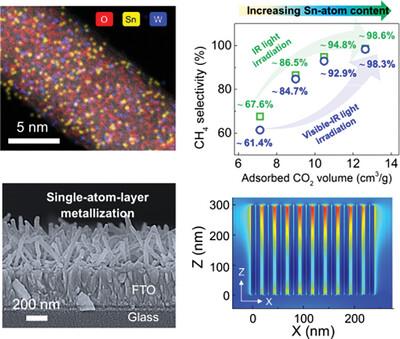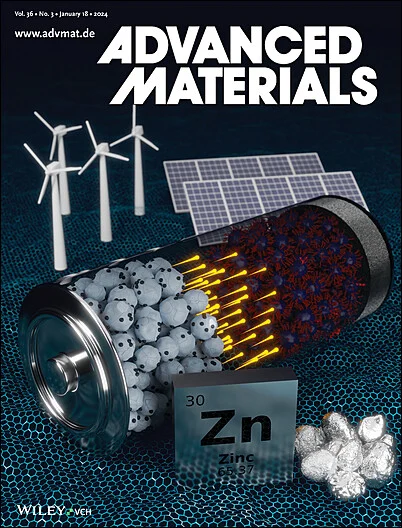Single-Atom-Layer Metallization of Plasmonic Semiconductor Surface for Selectively Enhancing IR-Driven Photocatalytic Reduction of CO2 into CH4
IF 27.4
1区 材料科学
Q1 CHEMISTRY, MULTIDISCIPLINARY
引用次数: 0
Abstract
Efficient harvesting and utilization of abundant infrared (IR) photons from sunlight is crucial for the industrial application of photocatalytic CO2 reduction. Plasmonic semiconductors have significant potential in absorbing low-energy IR photons to generate energetic hot electrons. However, modulating these hot electrons to selectively enhance the activity of CO2 reduction into CH4 remains a challenge. Herein, the study proposes a single-atom-layer (SAL) metallization strategy to enhance the generation of IR-driven hot electrons and facilitate their transfer from plasmonic semiconductors to CO2 for producing CH4. This strategy is demonstrated using a paradigmatic W18O49@W-Sn nanowire array (NWA), where Sn2+ ions are grafted onto exposed O atoms on the surface of plasmonic W18O49 to form a surface W-Sn SAL. The incorporation of Sn single atoms enhances plasmonic absorption in IR light for W18O49 NWA. The W-Sn SAL not only promotes CO2 adsorption and reduces its reaction activation energy barrier but also shifts the endoergic CO-protonation process toward an exoergic reaction pathway. Thus, the W18O49@W-Sn NWA exhibits >98% selectivity for IR-driven CO2 reduction to CH4 with an activity over 9.0 times higher than that of bare W18O49 NWA. This SAL metallization strategy can also be applied to other plasmonic semiconductors for selectively enhancing CO2-to-CH4 reduction reactions.

质子半导体表面的单原子层金属化可选择性地增强红外驱动的光催化将二氧化碳还原成甲烷的能力
从太阳光中有效收集和利用丰富的红外(IR)光子对于光催化还原二氧化碳的工业应用至关重要。质子半导体在吸收低能红外光子以产生高能热电子方面具有巨大潜力。然而,如何调节这些热电子以选择性地提高将 CO2 还原成 CH4 的活性仍是一个挑战。在此,研究提出了一种单原子层(SAL)金属化策略,以增强红外驱动热电子的产生,并促进其从等离子半导体转移到 CO2,从而产生 CH4。该策略利用典型的 W18O49@W-Sn 纳米线阵列 (NWA) 进行了演示,其中 Sn2+ 离子接枝到等离子体 W18O49 表面暴露的 O 原子上,形成表面 W-Sn SAL。锡单个原子的加入增强了 W18O49 NWA 对红外光的等离子吸收。W-Sn SAL 不仅能促进二氧化碳的吸附并降低其反应活化能势垒,还能将内能二氧化碳质子化过程转向外能反应途径。因此,W18O49@W-Sn NWA 在红外驱动的 CO2 还原成 CH4 的过程中表现出 98% 的选择性,活性是裸 W18O49 NWA 的 9.0 倍以上。这种 SAL 金属化策略也可应用于其他质子半导体,以选择性地增强 CO2 到 CH4 的还原反应。
本文章由计算机程序翻译,如有差异,请以英文原文为准。
求助全文
约1分钟内获得全文
求助全文
来源期刊

Advanced Materials
工程技术-材料科学:综合
CiteScore
43.00
自引率
4.10%
发文量
2182
审稿时长
2 months
期刊介绍:
Advanced Materials, one of the world's most prestigious journals and the foundation of the Advanced portfolio, is the home of choice for best-in-class materials science for more than 30 years. Following this fast-growing and interdisciplinary field, we are considering and publishing the most important discoveries on any and all materials from materials scientists, chemists, physicists, engineers as well as health and life scientists and bringing you the latest results and trends in modern materials-related research every week.
 求助内容:
求助内容: 应助结果提醒方式:
应助结果提醒方式:


